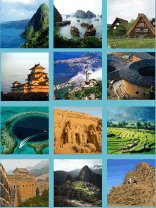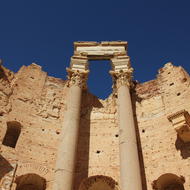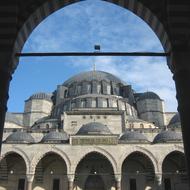Guide 9: Securing funding and investment
What this guide will tell you:
This guide will tell you some ways that you can secure investment in order to help make the aspirations developed from these guides for your site and the destination as a whole a reality.
Steps to success:
- Why this matters
-
Sustainability is always to an extent about financial sustainability. Having enough income to sustain the heritage values of the site for future generations is a critical issue. Money ultimately determines whether all of the possibilities presented in the previous Guides are actually feasible.
Resources are always finite. Very few sites have adequate investment to do everything they need/want to do, so all sites, to a greater or lesser extent, need to think about attracting additional/new funding and investment to make the progressive changes necessary for a more sustainable destination.
-
 The four ways to finance World Heritage – a beginner’s guide
The four ways to finance World Heritage – a beginner’s guide -
There are basically only four ways to finance and sustain your heritage site:
1) Taxation
The conventional model is based on the state, regional, or local government imposing taxation directly (through visitor taxes imposed at point of entry) or indirectly (through taxing tourism businesses) on the travelling public, which is then returned to the site as subsidy for conservation works. For many people engaged in the conservation of World Heritage sites, this will be the preferred model.
2) Raising commercial revenue on site
This is another common model in which site authorities raise revenue locally from increased or higher value ticket sales, retail, food and drink, accommodation, transport and experiences, and re-invest this into the conservation of the site. For many site management organisations, this is often the solution, but it carries all the potential negative issues that can result from greater footfall or increased economic exploitation of the site. Raising commercial revenue on site is important, but it will cover only a fraction of the tourism spending in your destination, the majority of which is not spent at the site (See Guide Seven, Adding value through products, experiences and services).
3) Raising commercial revenue beyond the site
Some sites can sell products, services, experiences, or intellectual property beyond the destination. A growing minority of World Heritage communities have developed business models that transcend the local resident and tourism demand for products and have developed revenue streams for products, services, experiences, or intellectual property from beyond the destination (See Guide Seven, Adding value through products, experiences and services).
4) Fundraising or working with others to secure investment
A growing number of sites are developing new fundraising models. You need to be clear what your revenue-generating strategy is, as it will inform how you develop your destination. That will be addressed in this Guide.
-
 Be clear how much funding/investment is needed to maintain and bring about the desired progressive changes to the site and destination
Be clear how much funding/investment is needed to maintain and bring about the desired progressive changes to the site and destination -
- Is there a funding shortfall to preserve, interpret, and enhance the values of the site?
- How much money do you need?
A sustainable tourism strategy (as set out in Guide 1, Understanding tourism at your destination) should identify the actions that need to be undertaken. From this, it is relatively simple to put a cost on the different actions and work out a timescale, which in turn, will enable an annual budget to be calculated.
Being clear about how much funding/investment you need and what you need it for is critical to the way that you attract it. The first questions any serious investor or donor are going to ask are:
- 'What do you need money for?’
- 'How much money do you need?’
- 'What benefit will I get from giving you money, and how will doing this help me achieve my objectives?’
- 'Why hasn't the government paid for this?'
You need to anticipate potential questions and provide clear answers.
-
 Be clear what you need funding/investment for
Be clear what you need funding/investment for -
Make a list of actions and/or activities that need to take place and an estimate of their costs. Then, identify those actions/activities that have no current funder. Being clear about the need for funding is one of the most important elements of fundraising. Some areas will attract investment and funding more easily than others, but at this stage, just be clear about what you need money for and why.
Identify the likely outcomes from those actions and activities. A simple action might have several different outcomes. For example, restoring a building or a habitat might be an end in itself, but it may also be:
- A means to alleviate poverty in the host community by offering craftsmen or women work
- Become an educational opportunity
- Give visitors a chance to engage in volunteering alongside a professional conservation worker
- Become an activity to share with schools and colleges
- Even become a visitor attraction where people can see the values of the site in action.
Think about the different potential outcomes of any given activity, starting with what you value as an outcome, and then working towards what other people might value.
-
 Identify funders and investors who might be interested in similar outcomes
Identify funders and investors who might be interested in similar outcomes -
Some of the following sources should be considered for funding (and others specific to your site!):
1) Governments and statutory bodies
In many sites there will be a relatively sustainable funding situation with the State Party or relevant bodies taking full responsibility for the costs of conserving, interpreting, and enhancing the site and the wider destination. Sadly, this will not always provide sufficient funding for the implementation of the strategy, so other sources of funding/investment may be necessary. World Heritage sites are global entities, so do not confine your analysis to local or national boundaries. Sometimes help is available through transnational funding, such as the EU, World Bank, or other State Parties with a particular interest in your kind of site or activities. For example, much of the funding for the Valley of the Kings in Egypt has come from Japan, so think more broadly about which governments and government agencies might be able to help.
2) Third sector charities, trusts, and foundations
In many societies around the world there are philanthropic trusts, charities, and organizations that have funds to invest in projects that meet their objectives. Having a basic understanding of these is important, as it may give you opportunities for investment. Again, think globally because many fundraising mechanisms are now global. Identify possible third sector donors and investors and think about what outcomes they will require for their investment – read their websites and funding guidance.
3) Corporate sponsorship
As a World Heritage site you are of significance to the whole world, and many responsible and philanthropic companies will value association with your site. Some businesses may wish to secure the benefits of public relations (PR) of being seen as investors in the preservation of the site or be involved in a specific project. However, be cautious about donors’ motivations and set clear ground rules and expectations about what is and is not appropriate. Start to make a list of companies with a link to the site, or which might be approached for other reasons to secure investment.
4) High net-worth individuals
Many people who have had the good fortune to become affluent are looking for ways to leave a lasting legacy, and there is no greater lasting legacy than to help preserve a World Heritage site for future generations. For this to happen, sites need to be able to present their needs, their projects, and the chance to invest in a structured manner. Think about where these individuals are, and how you can get their attention with a well-thought out pitch that will appeal to their philanthropy. When selecting individuals it is particularly important to be aware of their personal interests and values, and to craft individual-specific pitches.
5) Residents
Sometimes a great source of funding and investment lies right within the site – in the form of the local communities. Having a local community membership/donor scheme that encourages the involvement of local people in the preservation of the site can be a powerful tool. It becomes about more than the money. Sometimes people who have left the local community to go and work elsewhere are affluent and looking for ways to return benefit to the host community or the heritage of the site/destination. This can be made possible with new technologies and ideas like payroll giving or requests for donations for special initiatives. Think about how such a scheme might work and the ways that it could become a reality. For instance, would people enter a lottery each week in aid of the site? Is that appropriate to your society? If not, think of other ways to encourage them to contribute willingly.
6) Tourism organizations and businesses
The investment required will often be commercial investment in the tourism infrastructure rather than philanthropic contributions for conservation. However, this investment is also critical – remember, a crucial part of the discussion concerns what types of development and infrastructure are appropriate for the site and its values.
As we saw in Guide 6, Managing the development of tourism infrastructure, it is essential to set the limits and constraints on growth so developers and businesses understand what is and is not appropriate at a World Heritage site. In some states, there are legal mechanisms to return a share of the gain from new developments to conservation and local socio-economic development initiatives. Tourism businesses are often looking to establish schemes that let them achieve social, cultural, or environmental outcomes as a means to give something back, or raise their profile and perception they are a responsible business with good ethics.
There is a temptation to overestimate tourism businesses as an easy source of funding. In reality, many tourism businesses are small and only marginally profitable. Think about how you can transform tourism businesses into fundraisers, donors, or champions of the site. Think about how you can reach out to the tourism businesses and encourage them to develop more sustainable infrastructure or raise funds for conservation. Many businesses are quite willing to do this because it makes them look good to consumers, and other businesses will quickly follow suit when they see that it works.
7) Visitors
A growing number of destinations around the world are developing systems to encourage direct financial contributions from visitors to sustain the heritage at the heart of the destination, or for local socio-economic development. In some societies and cultures, the preference is for a mandatory tax imposed on visitors at the entry point, on the ticket price, or on beds in the accommodation sector. In other cultures, the preference is for voluntary contributions from visitors through communicating the site's needs and making it easy to donate during the holiday experience.
8) Citizens of the world
The rise of internet-based crowdsourcing models means that sites can, and should, reach out to an interested and sympathetic audience around the world. You can establish a relationship with them that makes them participants in the life of the site, as well as potential donors for social initiatives. The platforms already exist to do this, but very few sites have developed suitable projects and projected them into the world for donations.
-
 Match funders/investors who might be persuaded to fund/invest in particular outcomes or activities
Match funders/investors who might be persuaded to fund/invest in particular outcomes or activities -
Keep it simple – develop a table with three columns. The first column should list the most important actions/activities for the site/destination. The second column should list the potential outcomes of investing in those actions/activities. Finally, the third column should list the potential sources of investment/funding, and the particular focus that each funder would require before investing.
-
 Decide on a simple fundraising/investment strategy targeted at your most likely sources of appropriate investment
Decide on a simple fundraising/investment strategy targeted at your most likely sources of appropriate investment -
No destination has the time and resources to pursue all possible avenues of funding/investment simultaneously, so make strategic choices about how to spend your time and effort. In some cases, some governments may have an enlightened approach to sustaining their heritage, and recognize its value. Your efforts here might best be devoted to working with those government entities and agencies to explain/persuade the need for investment, and how it can deliver on government objectives.
If you are starting with limited or no resources, then you need to look at a simple mechanism to grow income and capacity (like outsourcing fundraising to tourism businesses) and build towards more complex and resource intensive models over time.
-
 Develop your pitch to funders/investors
Develop your pitch to funders/investors -
Develop projects/ideas that deliver your needs and your funder’s/investor’s objectives. Some well-resourced sites may publish a prospectus setting out their vision for the site, and the different ways that funders/investors can achieve different objectives. If resources are more modest, then write a simple summary of each project and bullet point why someone might want to invest in it, using the insights gained from your homework on prospective funders (see above ‘Identify funders and investors who might be interested in similar outcomes’).
Every potential donor has a right to a clear explanation of what you need money for, how you will spend their money, and what it will achieve in the long or short term. Sometimes it helps to think of your different avenues of funding as different people, each with a particular character – do a little character sketch about their interests/concerns. Write out a mini-script tailored to each particular donor to help you simulate how you might talk to that person about potentially helping you.
-
 Funding/investment is often competitive, so you must learn to communicate value
Funding/investment is often competitive, so you must learn to communicate value -
Major funders and investors will look for professionalism and the capacity and systems to handle money in a responsible, accountable, and professional manner. This means that your organizational structure is critical. Investors will be interested in:
- How their money will be handled
- The administrative costs of handling their money
- Your track record at handling monies and delivering outcomes through spending it
In some cultures, donors and investors prefer the fundraising body to be a registered charity or not-for-profit organization with published accounts and the regulation and transparency that comes with such systems.
-
 Bundle outcomes together to attract funders/investors to new activities
Bundle outcomes together to attract funders/investors to new activities -
Different funders and investors will have different concerns, but sometimes bundling together outcomes in more holistic solutions helps them to justify their investment. Some of the most effective fundraising programmes in the world creatively package outcomes from projects so they can appeal to new/different funders. For example, an education funder may be able to invest in conservation works if it is developed to include schools and colleges teaching conservation skills. The outcome desired may be conservation work, but by widening the project to be educational means, new or non-conservation-focused funders can also invest.
By looking at the needs and the funding opportunities in a holistic way, many organizations have found ways to attract investment and achieve their own – and the donor's – objectives, even when these seem quite different at first glance. Pragmatism is the watchword of fundraising – do what works.
-
 Establish mechanisms for fundraising from the tourism sector and particularly from visitors
Establish mechanisms for fundraising from the tourism sector and particularly from visitors -
Here are some options for establishing fundraising mechanisms (Note that the different mechanisms require more capacity and expertise as you descend the list):
1) Donation boxes and envelopes
One of the simplest forms of fundraising. You can ask businesses to position donation boxes or envelopes in appropriate places, and periodically hand in the funds collected to a central source.
2) Ticket levy schemes
Another relatively simple mechanism, you can ask attractions and transport providers to add a payback levy to their ticket price for the conservation of the site, and collect that levy before handing it in periodically to a central source. Businesses can, and should, tell visitors why they are doing this, and how it sustains the site.
3) Payback products
Businesses can add a payback premium to some of their products and publicise to customers that, every time that product is purchased, a set donation goes towards the conservation of the site. Again, businesses periodically hand the funds into a central source.
4) Charity auctions
Some conservation charities raise significant amounts of money through auctions of donated products, goods, and experiences.
5) Visitor gifting
Accommodation businesses (or those offering other services and products) can operate an 'opt-out' or an 'opt-in' system, asking visitors to donate an additional amount on top of the usual cost of the service to go towards conservation or community development. This is sometimes called 'travelers philanthropy’ and has operated in some destinations for more than two decades, raising significant amounts of money.
6) Membership or friends schemes
Visitors, businesses, or residents are asked to pay a membership fee to become a patron of the site. In return, they may be given some benefits, such as chances to visit restoration works, attend opening exhibitions at the site, etc. Sometimes local people are given special access to the site through such schemes, and visitors can maintain their support for the site long after their visit has ended.
7) Crowdsourcing
There are now numerous crowdsourcing websites that, for free or for a small charge, enable projects to be presented to potential donors around the world. The key to effective crowdsourcing is developing and presenting the actions/activities required at the site level in an attractive manner, appealing to donors’ philanthropy. On some sites, perks are added to contributions over a certain amount. The appeal of these sites is often the social nature of the help being provided, with people donating as a group, as friends from a business, a football team, church group, etc. They are a great way to attract large numbers of small donations, which all add up!
8) Payroll giving
Residents, visitors, or citizens of the world can donate a percentage of their weekly, monthly, or annual income to the site through a direct payment mechanism into a central source, which then funds conservation works. Because this is automated, it can be an effective and enduring way to raise funds, but encouraging sign up requires resources.
9) Legacy gifting
Residents, visitors, or citizens of the world are encouraged and assisted to write into their will an endowment to the conservation of the site. This is a way for anyone to leave a powerful and enduring legacy after a person's life. It is a deeply meaningful source of income that should be illustrated somewhere on the site, such as, for instance, a plaque listing the donors' names. However, be mindful that due to the nature of the donations, it can take time to deliver revenue.
10) Corporate sponsorship
Businesses are often keen to associate with some of the world's most important historic sites, regardless of whether they are locally based or not. The value is in the association with the site and being seen doing something good as a business, which is respected by both their customers and their staff. Not all businesses will be appropriate for all sites – selection needs to be conscientious – but opportunities do exist for great conservation work to be financed through this route.
11) Special events or experiences.
Some heritage sites have found other innovative ways to raise funds for conservation, such as offering access to filmmakers for use as a movie set, holding sporting events, or musical concerts. Clearly the first priority must be protecting the heritage and the intangible values of the site, as well as the quality of life of residents. Yet, often there is great scope for such activities which may be very lucrative in raising much needed funding for conservation – if the right experts are consulted in the process.
-
 With more advanced fundraising techniques you need to build capacity and fundraise in an increasingly professional manner
With more advanced fundraising techniques you need to build capacity and fundraise in an increasingly professional manner -
Grow your skills and capacity over time and aim to become professional in your fundraising. Fundraising is often an afterthought for some destinations, delivering tokenistic amounts of revenue. However, in the most dynamic destinations, fundraising is effectively a professional activity that resources itself, or turns seed capital invested by core stakeholders into a long-term revenue stream. Any fundraising strategy for a significantly sized site should set out the steps required to move from the starting point to a more professional approach with the capacity and skills to be self-sustaining.
The goal should be an ongoing donation-giving relationship, not a one-time donation. The best kind of donor is one that keeps on giving, preferably through a mechanism that is automated so the transaction costs stay low. This ties in nicely with the marketing goal of a destination, which should also be about lasting relationships to encourage future visits. Great destinations keep talking to their visitors, engaging them in activities and initiatives.
-
 It’s not just about money
It’s not just about money - If your site has very limited resources, it may be more effective initially to look for help from some of your residents, visitors, or sympathetic citizens of the world. Clay Shirky, an American writer, has written of there being a growing 'cognitive surplus' in the developed world – affluent people with free time who are often willing to use their education and professional skills to help good causes. You may already have an amazing web designer visiting your destination each year who could create a website for you at little or no cost as a philanthropic gesture, but you need to explain and communicate the need before anyone will recognise it and respond. Give people an opportunity to volunteer.
-
 Will tourists really donate?
Will tourists really donate? -
Yes, if the need is legitimate, and if it is simple, trustworthy, and quick. There is a growing body of evidence around the world that visitors do donate if the destination sets up appropriate structures that make it simple, not time consuming, and trustworthy by having a legal structure and clear philanthropic aims (charities or not-profit organizations work best because people do not like giving money to governments that also collect taxes). Schemes also need to be clear about the difference they will make, and why other sources like the government are not already paying for this action/activity.
Technology has limitations, simple is often better. Approximately one-half to two-thirds of people on the planet do not have smart phones or internet access from a computer, and while this percentage is rapidly decreasing, you still need to be wary of over-reliance on technology-based solutions. Many sites will have poor mobile phone reception, and many people will still prefer to give a cash donation rather than complete an online financial form for a financial transaction. Look at the full range of fundraising solutions and work out the approach, or combination of approaches, that will yield the best return on the investment of time and money.
-
 Online fundraising should not be confined to the destination
Online fundraising should not be confined to the destination - Fundraise where people spend their money, including at their computers in their homes. More than half of holidays are now booked online in some technologically advanced, affluent countries. As this may be the biggest transaction of a person’s holiday, asking for donations should be embedded into the online learning and booking systems. This means it must be part of the websites that visitors use to learn about the site, find accommodation and transport, and through which they book their holidays.
-
 Embed fundraising in a strategic approach
Embed fundraising in a strategic approach - Fundraising should be embedded in everything the destination does – a key part of the strategy, a protecting force for the heritage, an enabler for the local community, and part of the ongoing relationship that the destination has with its visitors. More and more, people value deeper and lasting relationships with the important places they visit, and in this context, making donations is seen as part of their commitment, something positive, and not a dull or resented obligation. There is also a growing body of evidence that says consumers expect destinations and tourism businesses to play a role in sustaining natural and cultural heritage.



